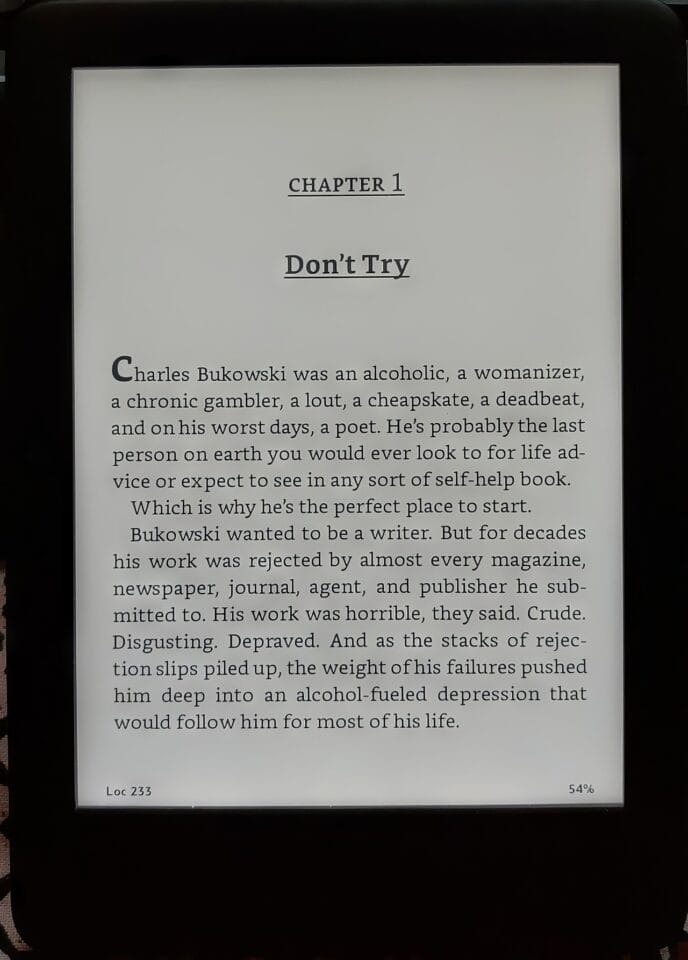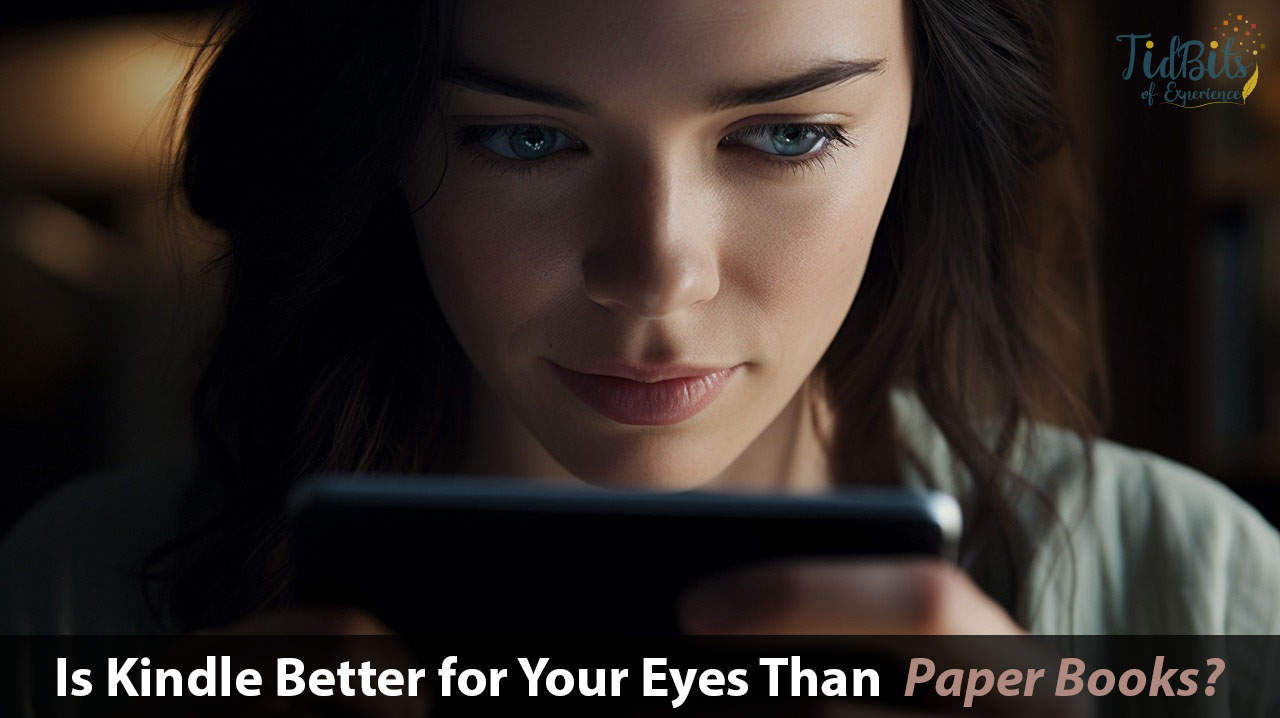Ever find yourself rubbing your eyes after a long reading session on your Kindle? You’re not alone—I was intrigued when my own peepers started resenting my obsession with digital reading! Having uncovered that owners of eReader devices read an average of 8 more books than those without, per the Pew Research Centre’s Internet & American Life Project, I got my detective glasses on to suss out if Kindles are truly kinder on our eyes than traditional paperbacks.
Ready to delve in for some eye-opening insights?
Key Takeaways
E-readers like Kindle, with their E-Ink technology, are designed to replicate the experience of reading on paper and are generally considered more eye-friendly than LCD screens on smartphones or tablets.
Reading on backlit screens can lead to potential eye problems such as eyestrain, headaches, reduced blinking, visual fatigue, and sleep disruption due to the blue light emitted by these devices.
Kindle offers features like adjustable brightness and LED lights that provide more consistent lighting across the screen, making it easier on the eyes compared to traditional books or other e-readers without these features.
While there are potential risks associated with reading on e-readers like Kindle, proper usage, including taking breaks and practicing good eye care habits, can help minimize any negative impact on eye health.
Table of Contents
The Debate: Books vs. Kindle

Hold onto your reading glasses, fellow moms. We’re diving headfirst into the heated debate of books versus Kindle. Now, I’m sure we all have a soft spot for that old-school smell of a freshly opened paperback and the satisfying sound of turning physical pages.
But let’s face it – in this fast-paced, digitized world where every mom is always on-the-go, Kindles offer unmatched convenience and portability.
But wait! Before you bid adieu to your stacks of traditional books (and possibly an avalanche waiting to happen), let’s not forget about eye health. E-readers like Kindle are storming the market with 62% dominance – impressive, right? However, questions surround their impact on our precious peepers.
Let’s explore further as we turn over – or should I say swipe through – each page of this captivating tale titled ‘Is Kindle Really Better for Your Eyes Than Books?’.
How eReaders Like Kindle Work

Alright, ladies, let’s take a deep dive into the fascinating world of eReaders like our beloved Kindle. This handy device is not just an electronic gadget but also your new best friend that lets you download and store hundreds of books in one convenient place.
And no, it doesn’t need an “every five minutes” internet connection. Once you’ve downloaded your favorite novels or self-help guides, they’re yours to read whenever and wherever much like a traditional book!
Now here’s where things get interesting: Kindle uses E-Ink technology (one of those display technologies mentioned earlier). Unlike your smartphone or tablet that has an LCD screen with backlighting – which can be harder on the eyes – E-Ink replicates something close to actual ink on paper! It reflects ambient light from your environment instead of shining light directly into your eyes.
The result? An incredibly comfortable reading experience, even for prolonged periods! Plus, this magic “E-ink” thingy takes its sweet time refreshing the page only when you flip to the next, conserving battery life significantly compared to other e-readers out there.
Some models also come with built-in LED lights providing more consistent lighting across the screen – perfect for late-night reading under the covers without disturbing anyone else in bed (husband, partner, kids..you name it!).
But hey, don’t forget about blinking too during these cozy nocturnal readings sessions; keeping up with hydration will help avoid dry eye symptoms.
And if you thought all this tech means constantly charging it up – think again! Due to their unique features, such as adjustable brightness capabilities and efficient power usage, primarily while changing pages (no power is used at all to maintain a static image), Kindles have battery lives that laugh in the face of most tablets out there! So go ahead and pack one for that long weekend getaway without worrying about taking along chargers or looking around for outlets everywhere you go.
Empowered by important facts? Absolutely! Let’s march forward, then…
Impact of Kindle on Eye Health
E-readers like Kindle have been a topic of concern when it comes to eye health. Studies suggest that reading on LCD eReaders can cause higher visual fatigue compared to E-ink eReaders and paper books.
However, newer LCD screens with better resolution and faster refresh times may limit these issues. It’s important to consider possible eye problems such as pain around the eyes, fatigue, blurred vision, and headaches from excessive use.
To delve deeper into this debate, let’s explore the effects of digital reading on sleep patterns next. Remember, though, there are ways to mitigate these issues!
Details of Relevant Studies
Ever find yourself feeling like a nerdy scientist as you comb through studies about e-readers and eye health? Me too, Mom friend! Let’s dig into a few key findings together from the comfy couches of our lives.
A study from way back in 2013 showed that LCD eReaders could be causing us more visually-induced weariness than E-ink readers or plain old paper books (but hey, getting tired eyes is just another excuse for coffee!).
Newer LCD gadgets boast higher resolution and faster refreshing times, which some experts believe might help save our peepers.
Here’s an interesting fact – LED lights built into e-readers spread light evenly across pages, minimizing the enemy we call eyestrain. But there’s a catch! On the flip side, reading using backlit screens from devices like smartphones or tablets might cut down on how much we blink— leading to dry eyes (and I don’t mean emotionally!).
Dr. Travis Meredith says screen proximity doesn’t really hurt your vision; it’s usually other aspects like insufficient lighting and not giving your eyes rest time contributing towards fatigue (kinda sounds like parenting itself).
So next time you’re sipping wine after a hectic day avoiding crayons scribbled on walls while sneaking in chapter breaks on your Kindle Paperwhite – remember these little tidbits learned from fellow mom-science nerds out there!
Possible Eye Problems to Consider
As a mom, it’s important to consider the potential eye problems that can arise from using e-readers like Kindle. Here are some things to keep in mind:
- Eye strain: Reading on a screen for long periods can cause eye strain, leading to discomfort, fatigue, and even blurred vision.
- Headaches: Staring at a bright screen for extended periods may trigger headaches in some individuals.
- Digital eyestrain: The blue light emitted by LCD screens can contribute to digital eyestrain, causing symptoms such as dry eyes and eye irritation.
- Reduced blinking: When we read on devices with backlit screens, like smartphones or tablets, we tend to blink less frequently. This can result in dry eyes and discomfort.
- Visual fatigue: LCD displays can lead to visual fatigue due to their pixel density and perceived flickering effect.
- Sleep disruption: The blue light emitted by screens can interfere with the production of melatonin, a hormone that regulates sleep patterns. Reading on devices before bed may affect your ability to fall asleep easily.
Does Kindle Affect Sleep?
I have come across many articles and studies that discuss the impact of reading on a Kindle before bedtime and whether it can affect sleep. According to Harvard Medical School, the blue light emitted by electronic devices like Kindles can disrupt our natural sleep patterns by suppressing melatonin production.
Melatonin is a hormone that helps regulate our sleep-wake cycle.
However, there are ways to minimize this potential disruption. One study conducted at the University of North Carolina found that using e-readers with built-in lighting, like the Kindle Paperwhite, rather than backlit devices such as tablets or laptops, significantly reduced sleep disturbances.
To further protect your sleep quality when using a Kindle in bed, experts recommend avoiding screen time for at least an hour before going to sleep. Instead of turning to your e-reader during those precious moments leading up to bedtime, consider opting for traditional books in print format.
This way, you can still enjoy a good read without any potential effects on your sleep.
It’s worth noting that individual experiences may vary, so listen to what works best for you and pay attention to how certain activities affect your own ability to fall asleep and stay asleep throughout the night.
It’s all about finding a balance between digital convenience and taking care of our well-being – something every mom knows all too well!
Frequently Asked Questions About Whether Kindle is Really Better for Your Eyes Than Books
Does reading on a Kindle strain your eyes less than reading physical books?
While some studies suggest that reading on a Kindle may cause less eye strain compared to physical books, it ultimately depends on individual preferences and habits. Factors such as font size, screen brightness, and reading duration can affect eye fatigue.
Are Kindles equipped with features to reduce eye strain?
Yes, most Kindles have built-in adjustable backlighting that allows users to customize the screen brightness according to their preference. Additionally, they offer adjustable font sizes and fonts that make reading more comfortable for individuals with vision problems.
Can prolonged use of a Kindle lead to eye damage or vision problems?
There is no definitive evidence suggesting that using a Kindle for extended periods directly causes eye damage or vision problems. However, like any electronic device with screens emitting blue light, excessive usage without breaks can potentially contribute to digital eyestrain symptoms such as dryness or discomfort.
How can I minimize the potential negative effects of using a Kindle on my eyes?
To minimize potential negative effects while using a Kindle, you can follow these tips: Take regular breaks from extended reading sessions, Adjust the screen brightness and font settings according to your comfort level, Maintain good posture and proper viewing distance, Use ambient lighting in the room instead of relying solely on the device’s backlighting
Conclusion
After weighing the evidence and considering various factors, it has become clear that Kindle is indeed better for your eyes than books. While traditional books have their charm, eReaders like Kindle offer features such as E Ink technology and adjustable brightness that make reading easier on the eyes.
With proper usage, incorporating breaks, and practicing good eye care habits, moms can enjoy their favorite reads without compromising eye health. So go ahead and embrace the digital revolution – your eyes will thank you!



